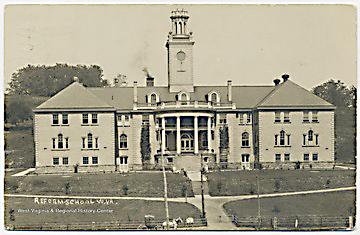By William “Skip” Deegans
 Growing up in West Virginia, boys who were on the cusp of mischief would often be threatened with being sent to Pruntytown (commonly pronounced “pruneytown”). Pruntytown was the site of the West Virginia Reform School (pictured). The image most kids had of a prison came from movies, and it was one of San Quentin or Alcatraz. It seemed that the West Virginia Reform School was likely a smaller version of one of those prisons. The thought of spending a night there was an effective deterrent.
Growing up in West Virginia, boys who were on the cusp of mischief would often be threatened with being sent to Pruntytown (commonly pronounced “pruneytown”). Pruntytown was the site of the West Virginia Reform School (pictured). The image most kids had of a prison came from movies, and it was one of San Quentin or Alcatraz. It seemed that the West Virginia Reform School was likely a smaller version of one of those prisons. The thought of spending a night there was an effective deterrent.
The West Virginia Reform School was established in 1889 by an act of the West Virginia Legislature and located in Pruntytown, the former county seat of Taylor County. The location was described as healthful and quite picturesque, and the institution opened in 1890 with six boys. The objective of the school was “moral reformation, mental training, development and care of male minors between eight and eighteen years.” While both black and white boys were incarcerated there, they did not share the same lodging or dining room. The boys had an opportunity to learn a trade, and courses were offered in plumbing, electricity, printing, tailoring, laundering, shoemaking, carpentry, blacksmithing, brick making, coal mining, sewing, baking and general agriculture.
A similar school for girls was established in 1897. Located in Salem, the West Virginia Industrial Home for Girls hosted “incorrigible girls, truants, beggars and those in such surroundings that they are in danger of falling into habits of immortality and vice…” From ages eight to eighteen, they may be committed to the home until they are twenty-one.
The name of the school in Pruntytown was changed to the West Virginia Industrial School For Boys. When Paul Mones, a legal advocate for incarcerated teens, visited the boys’ school in the early 1980s, he found it to be a Draconian institution where the boys were severely punished. The Pruntytown school closed in 1983, and the boys were integrated in the girls’ facility in Salem. The name was changed to the West Virginia Industrial Home For Youth. In 2013, it was converted to an adult correctional facility, no longer confining boys and girls.
Photo courtesy of the West Virginia University Regional History Center.
Sources: West Virginia Archives & History, Clio. Doddridge County Heritage Guild.


